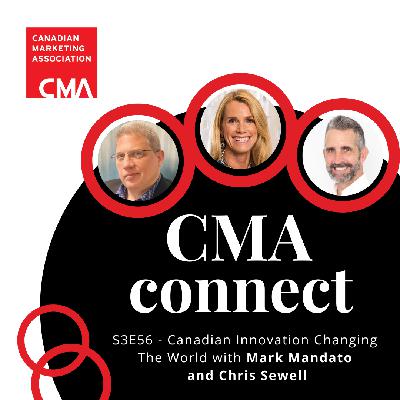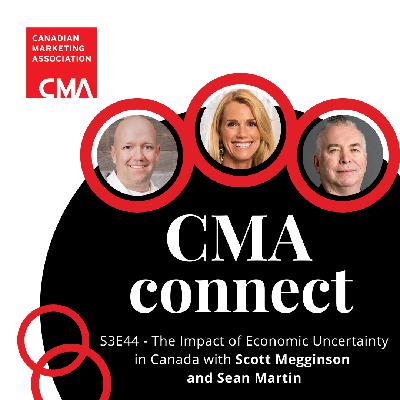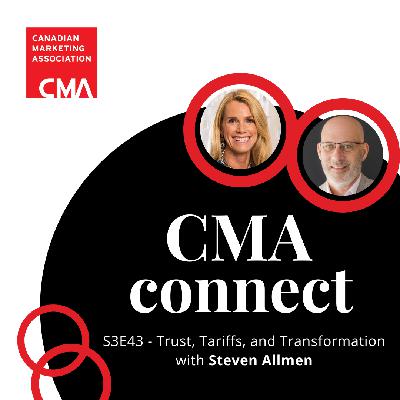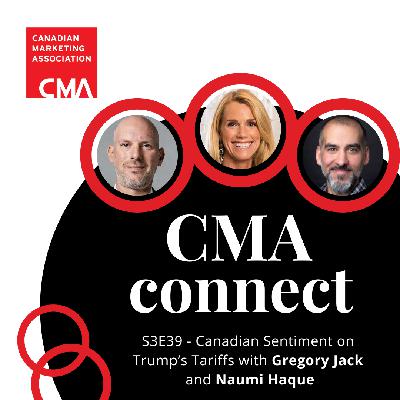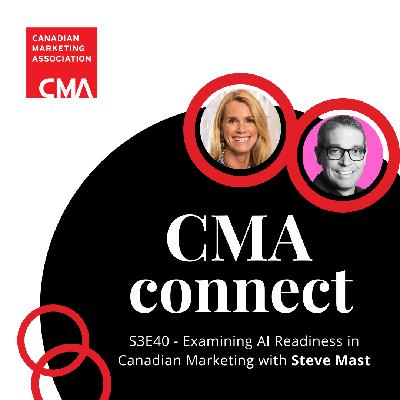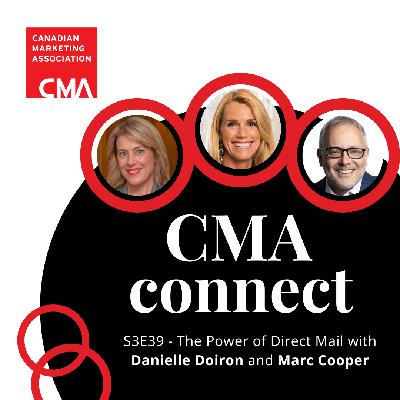EP45 - Actionable Data Strategies, Privacy, AI & Enterprise Leadership with Jan Kestle
Description
How can marketers harness data-driven insights while navigating privacy and emerging technologies? CMA CEO Alison Simpson welcomes Jan Kestle, founder and President of Environics Analytics, to discuss why data strategies must be enterprise-led, moving from "so what?" insights to "now what?" outcomes. Their conversation covers privacy-compliant collaboration platforms that reveal which advertising works, how privacy compliance enables effective marketing, and AI's role in enhancing data interpretation.
00;00;01;23 - 00;00;06;09
Presenter
Welcome to CMA Connect, Canada's marketing podcast, where industry experts discuss how marketers must manage the tectonic shifts that will change how brands and businesses are built for tomorrow, while also delivering on today's business needs. With your host, CMA CEO, Alison Simpson.
00;00;22;17 - 00;00;49;16
Alison
Welcome to CMA Connect, the podcast where we dive deep into the world of marketing with industry leaders and innovators. Today, I am absolutely thrilled to welcome a true pioneer in the realms of data, statistics and marketing, Jan Nestle. Jan is the founder and president of Environics Analytics. With over five decades of experience, Jan has been at the forefront of using data and analytics to solve complex business problems and help shape the marketing landscape in Canada and beyond.
00;00;49;18 - 00;01;17;08
Alison
Jan's journey is nothing short of inspirational. From her early days at the Ontario Statistical Centre to founding Environics Analytics in 2003, she is consistently pushed the boundaries of what's possible with data-driven insights. Her contributions to the industry are massive and include developing the Prism Segmentation system and the Envision Business Intelligent platform, tools that have revolutionized how marketers understand and can reach their audiences.
00;01;17;10 - 00;01;42;08
Alison
In recognition of her groundbreaking work. Jan was honoured with the Canadian Marketing Association's Lifetime Achievement Award in 2022, truly cementing her status as a trailblazer in our field. In today's episode, we'll explore Jan's really fascinating career path and discuss a range of topics that are reshaping the marketing landscape. From the evolving role of data and predictive analytics, to solving business problems to navigating data privacy complexities,
00;01;42;10 - 00;02;01;23
Alison
we plan to delve into the future of data-driven marketing. We're also going to touch on AI, enhanced customer journey mapping, ethical considerations and hyper-personalized marketing, and the importance of data sharing and driving business success. There is no shortage of great topics that Jan can speak to, and it is an absolute pleasure, Jan, to welcome you to CMA Connect today.
00;02;01;26 - 00;02;20;00
Jan
Well, thank you very much and thank you for having me. I love working with the CMA. I think the CMA in the past few years has done an incredible job of having conversations that are very important to marketers and to the whole business community in Canada. So it's my pleasure to be with you here today, Alison.
00;02;20;02 - 00;02;40;21
Alison
And well, thank you so much. Jan, I don't use the term pioneer lightly. You've been a pioneer in data statistics in the marketing professions. The fact that you've been a leading innovator in all three is also a sign that you didn't really take a traditional path to your career. You also succeeded as a woman at a time that was, very sadly, very rare.
00;02;40;24 - 00;02;52;23
Alison
And I really find your story inspiring, both from a professional perspective and also from a personal perspective. I know many of our listeners would as well. So I'd love to start by having you share a little bit about your journey.
00;02;52;25 - 00;03;22;06
Jan
Sure. Thank you. Well, sometimes when I think about my long career, which I guess part of what makes me a pioneer is it goes so far back, is I think about three aspects to my career. First of all, as you mentioned, I worked as a government statistician, and then I worked as a sales and product development person and eventually a leader in a company that was well-established and owned by various players in the information business.
00;03;22;08 - 00;03;41;01
Alison
And then finally, in the latter part of my career, actually started a business and built that. And for some people, it's kind of like, well, how did you decide to go from a government job to leading and working in the private sector and then running a pretty interesting business in the private sector? Why did you decide to start your own business?
00;03;41;01 - 00;04;03;13
Jan
And always gives me pause when I think about it that way, because to me, it's been a continuum of figuring out how data and mathematics can really help simulate realities and help people solve problems, whether it's for business or social services or, you know, how we make Canada run better? I've always been excited about being able to use information to do that.
00;04;03;18 - 00;04;32;24
Jan
The truth is, I, I have a degree in applied math, which is kind of like a combination of math and physics, and I graduated in a class of four women out of 140 classmates. And it was difficult, even being, you know, a good student and high in the rankings of my class. It was difficult to to get jobs for women in those scientific, and honestly, in any business in that day and age.
00;04;32;24 - 00;05;04;18
Alison
So I was very excited to take on my first job as a survey statistician and editor in the provincial government. And that was when we didn't even have computers, never mind AI. We put data on spreadsheets that was actual pieces of paper. We edited questionnaires with red pencils. We shared our work with our partner across the table to do QA, and then we added up rows and columns in order to create data that went into large statistical outputs.
00;05;04;18 - 00;05;31;18
JAn
I always say I got really good training on thinking about what the data are telling you and what's missing and what makes sense by being right down in the trenches. Eventually, in that particular role, I moved on to doing a lot of negotiating for the priorities for Ontario and the federal provincial context. But eventually I was leading that organization, and I, I enjoyed very much the work that I got to do in the policy side.
00;05;31;20 - 00;06;03;28
Jan
But my choices for a new challenge were to leave the statistics and the data part of of the work and move into more of a government policy job. But I had the opportunity to go and work for the first company in Canada that took data and demographics and created customized versions of that that businesses could use. Compusearch was the pioneering company in that field, and they'd been around for about 15 years and mainly working for retailers.
00;06;04;00 - 00;06;27;07
Jan
But they started to branch out and they recruited someone who really understood packaged goods, and they understood someone who worked in the financial sector. And they came and recruited me as someone who worked with governments and not-for-profits. And I joined, actually only took me like five days to make a decision to leave my pension and all that government work and take this opportunity.
00;06;27;07 - 00;07;02;23
Jan
And I went into sales and I'd never been in sales. I'd done a lot of business and relationships, but my first job there was selling the data that they had produced back to the government sector, and that was exciting. And led me to an opportunity to work on the product side, is how do we take data and turn it into information, because many organizations can't really invest in building data and doing the work from the ground up. You actually have to turn data into a product or a service that can be actionable, that can make a difference to a community or to a business.
00;07;02;23 - 00;07;26;00
Jan
So I went from being the statistician to being the sales person and understanding my customer's needs, and then going into product, and then eventually to president of that organization during its largest period of growth, which was the time period when people got computers on their desks, desktop computers, we went into desktop mapping. It was just the very beginning.
00;07;26;02 - 00;07;52;06
Jan
It wasn't even the CRM era. It was what we call database marketing. When we were starting to mine data and combine the kind of data that brands had about their customers, quite limited, with the data that we had about postal codes. So I always think, you know, all these parts of this journey really enabled me to think about how to make data help people make good decisions.
00;07;52;08 - 00;08;21;26
Jan
And eventually Compusearch was sold a few times and, and, you know, kind of went the route of what often happens with little businesses when they become successful. They they kind of became a part of selling software. And you know, a more bundled solution. And a few of us had a lot of feedback from our former customers to say, we really want people who focus on the data and the customized solutions or implementing the standard solutions in a customized way.
00;08;21;26 - 00;08;52;21
Jan
And so, you know, the story is pretty well known. I decided to start a new business basically replicating building the data, but also helping people understand how to use the data. And that's what we started Environics Analytics. Our funding came from the traditional market research company, Environics Research, t


